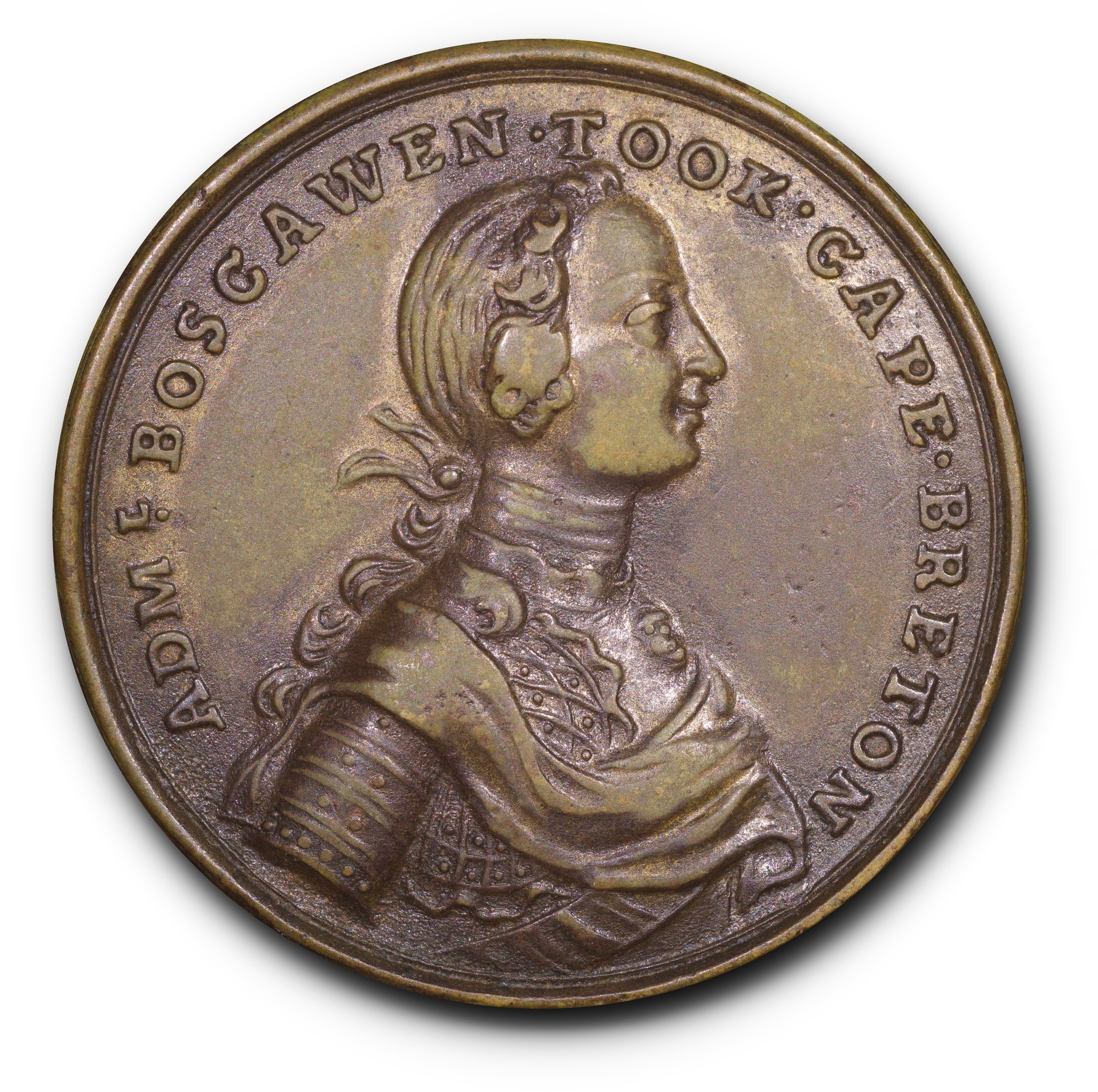1758 Louisbourg Taken Medal. Betts-403, Leroux-851, Breton-39, Eimer-659. VF-XF.
Brass. 40mm. 16.3 grams. These iconic pinchbeck medals commemorate the British capture of Louisbourg, the French fortress on Ile Royale, now Cape Breton, Nova Scotia. British naval forces were under the command of Admiral Edward Boscawen, while Major General Jeffrey Amherst oversaw control of the army. The siege itself was orchestrated by Prime Minister William Pitt. More than 14,000 soldiers travelling on nearly 190 ships commenced their attack on the morning of June 8, 1758. It took 48 days before the French capitulated. The battle was a momentous victory for the British during the Seven Years’ War (Quebec City and Montreal would fall soon after), widely celebrated through the issuance of medals like this.
The obverse depicts Admiral Boscawen facing right and dressed in military armour with the legend above: ADM L. BOSCAWEN . TOOK . CAPE . BRETON. The reverse shows a charming, if crude, depiction of the siege, with five battleships in the foreground and a view of the attack on the fort in the background with a mortar striking the tower on the hill. LOUISBOURG is above, while the date JUL 26 1758 appears in the exergue.
This is a glossy representative with brassy-gold and violet patina. These medals were not especially well-made; examples were often poorly preserved and never especially sharp to begin with. This piece exhibits a trace of wear, but detail remains bold on the portrait, ships, ocean lines, and legends. The rims are strong and unmarked, and there is just a touch of peripheral planchet roughness around the obverse lettering. A scarce medal in any grade but rarely offered this well-preserved.
Brass. 40mm. 16.3 grams. These iconic pinchbeck medals commemorate the British capture of Louisbourg, the French fortress on Ile Royale, now Cape Breton, Nova Scotia. British naval forces were under the command of Admiral Edward Boscawen, while Major General Jeffrey Amherst oversaw control of the army. The siege itself was orchestrated by Prime Minister William Pitt. More than 14,000 soldiers travelling on nearly 190 ships commenced their attack on the morning of June 8, 1758. It took 48 days before the French capitulated. The battle was a momentous victory for the British during the Seven Years’ War (Quebec City and Montreal would fall soon after), widely celebrated through the issuance of medals like this.
The obverse depicts Admiral Boscawen facing right and dressed in military armour with the legend above: ADM L. BOSCAWEN . TOOK . CAPE . BRETON. The reverse shows a charming, if crude, depiction of the siege, with five battleships in the foreground and a view of the attack on the fort in the background with a mortar striking the tower on the hill. LOUISBOURG is above, while the date JUL 26 1758 appears in the exergue.
This is a glossy representative with brassy-gold and violet patina. These medals were not especially well-made; examples were often poorly preserved and never especially sharp to begin with. This piece exhibits a trace of wear, but detail remains bold on the portrait, ships, ocean lines, and legends. The rims are strong and unmarked, and there is just a touch of peripheral planchet roughness around the obverse lettering. A scarce medal in any grade but rarely offered this well-preserved.
Brass. 40mm. 16.3 grams. These iconic pinchbeck medals commemorate the British capture of Louisbourg, the French fortress on Ile Royale, now Cape Breton, Nova Scotia. British naval forces were under the command of Admiral Edward Boscawen, while Major General Jeffrey Amherst oversaw control of the army. The siege itself was orchestrated by Prime Minister William Pitt. More than 14,000 soldiers travelling on nearly 190 ships commenced their attack on the morning of June 8, 1758. It took 48 days before the French capitulated. The battle was a momentous victory for the British during the Seven Years’ War (Quebec City and Montreal would fall soon after), widely celebrated through the issuance of medals like this.
The obverse depicts Admiral Boscawen facing right and dressed in military armour with the legend above: ADM L. BOSCAWEN . TOOK . CAPE . BRETON. The reverse shows a charming, if crude, depiction of the siege, with five battleships in the foreground and a view of the attack on the fort in the background with a mortar striking the tower on the hill. LOUISBOURG is above, while the date JUL 26 1758 appears in the exergue.
This is a glossy representative with brassy-gold and violet patina. These medals were not especially well-made; examples were often poorly preserved and never especially sharp to begin with. This piece exhibits a trace of wear, but detail remains bold on the portrait, ships, ocean lines, and legends. The rims are strong and unmarked, and there is just a touch of peripheral planchet roughness around the obverse lettering. A scarce medal in any grade but rarely offered this well-preserved.

